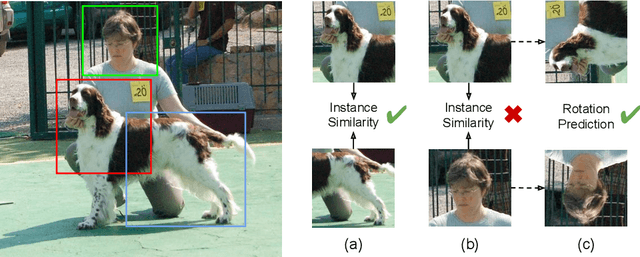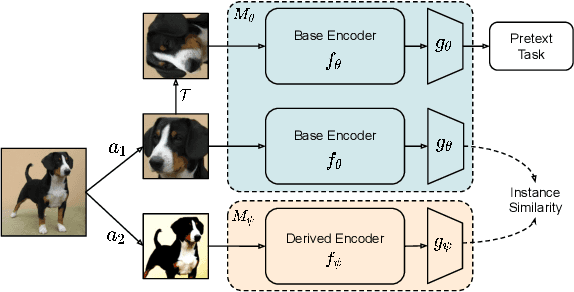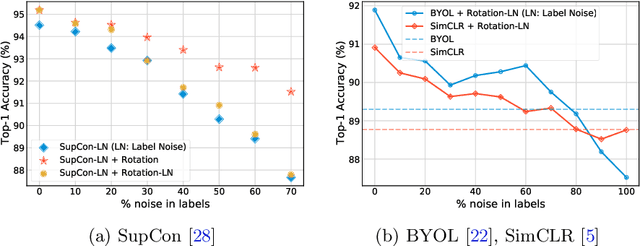Priyam Dey
ProFeAT: Projected Feature Adversarial Training for Self-Supervised Learning of Robust Representations
Jun 09, 2024



Abstract:The need for abundant labelled data in supervised Adversarial Training (AT) has prompted the use of Self-Supervised Learning (SSL) techniques with AT. However, the direct application of existing SSL methods to adversarial training has been sub-optimal due to the increased training complexity of combining SSL with AT. A recent approach, DeACL, mitigates this by utilizing supervision from a standard SSL teacher in a distillation setting, to mimic supervised AT. However, we find that there is still a large performance gap when compared to supervised adversarial training, specifically on larger models. In this work, investigate the key reason for this gap and propose Projected Feature Adversarial Training (ProFeAT) to bridge the same. We show that the sub-optimal distillation performance is a result of mismatch in training objectives of the teacher and student, and propose to use a projection head at the student, that allows it to leverage weak supervision from the teacher while also being able to learn adversarially robust representations that are distinct from the teacher. We further propose appropriate attack and defense losses at the feature and projector, alongside a combination of weak and strong augmentations for the teacher and student respectively, to improve the training data diversity without increasing the training complexity. Through extensive experiments on several benchmark datasets and models, we demonstrate significant improvements in both clean and robust accuracy when compared to existing SSL-AT methods, setting a new state-of-the-art. We further report on-par/ improved performance when compared to TRADES, a popular supervised-AT method.
DART: Diversify-Aggregate-Repeat Training Improves Generalization of Neural Networks
Feb 28, 2023Abstract:Generalization of neural networks is crucial for deploying them safely in the real world. Common training strategies to improve generalization involve the use of data augmentations, ensembling and model averaging. In this work, we first establish a surprisingly simple but strong benchmark for generalization which utilizes diverse augmentations within a training minibatch, and show that this can learn a more balanced distribution of features. Further, we propose Diversify-Aggregate-Repeat Training (DART) strategy that first trains diverse models using different augmentations (or domains) to explore the loss basin, and further Aggregates their weights to combine their expertise and obtain improved generalization. We find that Repeating the step of Aggregation throughout training improves the overall optimization trajectory and also ensures that the individual models have a sufficiently low loss barrier to obtain improved generalization on combining them. We shed light on our approach by casting it in the framework proposed by Shen et al. and theoretically show that it indeed generalizes better. In addition to improvements in In- Domain generalization, we demonstrate SOTA performance on the Domain Generalization benchmarks in the popular DomainBed framework as well. Our method is generic and can easily be integrated with several base training algorithms to achieve performance gains.
Towards Efficient and Effective Self-Supervised Learning of Visual Representations
Oct 18, 2022



Abstract:Self-supervision has emerged as a propitious method for visual representation learning after the recent paradigm shift from handcrafted pretext tasks to instance-similarity based approaches. Most state-of-the-art methods enforce similarity between various augmentations of a given image, while some methods additionally use contrastive approaches to explicitly ensure diverse representations. While these approaches have indeed shown promising direction, they require a significantly larger number of training iterations when compared to the supervised counterparts. In this work, we explore reasons for the slow convergence of these methods, and further propose to strengthen them using well-posed auxiliary tasks that converge significantly faster, and are also useful for representation learning. The proposed method utilizes the task of rotation prediction to improve the efficiency of existing state-of-the-art methods. We demonstrate significant gains in performance using the proposed method on multiple datasets, specifically for lower training epochs.
 Add to Chrome
Add to Chrome Add to Firefox
Add to Firefox Add to Edge
Add to Edge